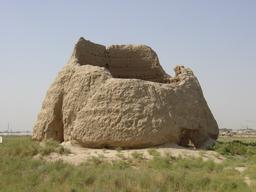
Antique storage depot
We originally planned to only travel through Turkmenistan on our way elsewhere, as is usually done by globetrotters in Central Asia. There is practically no information about this country so we did not expect any particular attraction. Fortunately before we left we met David Berghof who lives in Turkmenistan for many years now and thanks to his small travel agency Stantours in Berlin turned out to be a first-class contact for us. It didn't take long for David's descriptions of the country and the people to make our mouth water; we decided that the complicated entry procedure would be worth it, because now we want to see this mysterious country that has been more or less unknown to most of the tourist world. First of all, David gave us a certified letter of reference from the Ministry of Tourism to obtain a visa. We had to list all particular travel areas and then these were entered into the visa documents. In addition to that we had to hire an obligatory guide for the areas we chose in Turkmenistan, which is useful.
On the 19th of August we are ready to go. Equipped with all the required documents, we drive from Bukhara to the Turkmenian border near Farab. Leaving Uzbekistan is no problem. The officials at the border ask us - as we have experienced several times before - for something to sweeten their salary or they try to speak the few German words they know such as eins, zwei, drei, vier, guten Tag und Hände hoch (one, two, three, four, good day and hands up!). Meanwhile we' ve become used to this "game" and stay calm: Just don't show any fear! On the Turkmenian side we are forced to take a break. Due to the border guards' lunch break that usually lasts long, the border is closed and at 45 degrees Celsius we are glad to have air-conditioning in the middle of the desert. When we are finally allowed to cross the border, our guide Oleg arrives to help us with the entry formalities. He brings us another pack of documents to supposedly simplify bureaucratic procedures. The motto in Turkmenistan is "no paper, no journey." The negotiations to receive a road permit prove especially difficult. After long deliberations the officer in charge informs us that we have to pay a fee of $575 US, which includes mandatory car insurance, something we actually don't need. Unfortunately our worldwide valid insurance certificate is of no help. The main problem is the validity period of the permit of a maximum of fifteen days, which is too short for our planned trip of 22 days. We delay the problem by asking for a permit to drive to Ashgabat where we plan to discuss the matter at the traffic police headquarters. This is only the beginning - we need a total of four permits for the various routes in Turkmenistan and pay "only" $372 US (!) as road toll for the entire travel period. We feel as if we' d been transported back to the Silk Road era, when the caravan leaders had to regularly pay a high road toll. Our mood picks up though when we stop to tank up and pay a rather symbolic price of $1 US for 70 liters of diesel fuel. Considering the entire 3,500 kilometers we plan to drive in this country the expensive toll is compensated by this low price.
The first tourist highlight we visit is located near Mary: the impressive ruins of Merv. Until its destruction by the Mongolians in 1221, Merv had been an important center for culture and trade in the Silk Road and apart from Baghdad the largest city in the Islamic world. What' s remarkable is that in a area totaling 120 square kilometers (!) you can see all epochs of the city's development from the ancient to the Middle Ages: the rebuilt city having been erected alongside the destroyed ruins. We are especially amazed at the 12th century ice storage depot. This made it possible to store a cold winter's ice in the midst of the desert for up to two years - "camel milk on the rocks" and this without electricity!
 Antique storage depot |
It got particularly interesting after leaving the typical tourist spots and driving off road 60 kilometers through the Karakum Desert and visiting the excavation sites of Gonur. In this prohibited zone we visit the foundation walls of settlements, graves and a Bronze Age palace. We also find the 3,000-year old "high-tech remnants" of an antique air-conditioning system, canalization system and a ceramics kiln showing witness to a buried advanced civilization. There are thousands of broken pieces of old ceramic vases and other antique goods in the sand. It is difficult to find a place to camp without pottery shards. Ute uses a large piece of pottery to protect the gas stove against the wind. Who else has can say they have a 3000-year old kitchen?
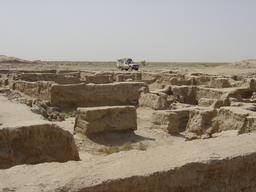 Back to the Bronze Age |
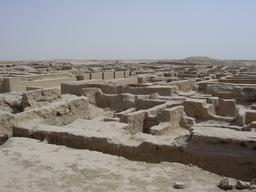 Gonur palace |
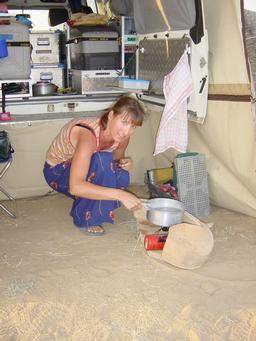 3000-year old kitchen |
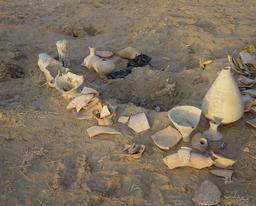 Antique pottery shards everywhere |
We go to Ashgabat, the capital of Turkmenistan, where we meet our friend Sabine who will join us on our tour for two weeks. Her arrival is like Christmas to us, because she brings us badly needed things and tidbits from home that we missed terribly.
To us Ashgabat looks like a very modern and tidy city. Noticeable are the parks with their oversized water fountains, presenting a sharp contrast to the near-by desert. State President Turkmenbashi seems to take political affairs seriously by the innumerable pictures showing his portrait. From every street and square you can spot at least ten large posters of his portrait. Particularly beautiful are the gilded, oversized statues of the president. Just recently the leader of all Turkmen had himself appointed president for life faithful to the motto "I am the State." The months and days of the week were renamed according to his whim. Naturally the year's first month now bears the name of the state president.
 Turkmenbashi on the pillar |
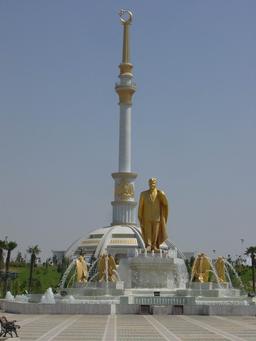 Turkmenbashi in gold |
 Turkmenbashi posters everywhere |
Fortunately we discover the true flair of Central Asia at the Tolkuchka Bazaar outside of the city where you can buy any trading wares imaginable.
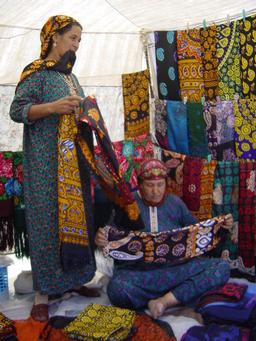 Bazaar in Ashgabat |
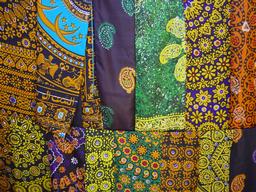 Bazaar in Ashgabat |
Ninety kilometers north of Ashgabat we set up our camp in Kow Ata. The next morning we climb through an 80-meter deep crevice down into the mountain where we find a huge cave with a lake fed by a warm source. Because it is extremely dark and we decide to swim with our headlamps on our heads. The bats fly very close to our heads.
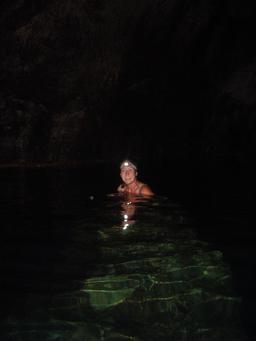 Swimming with headlamps |
Our journey continues from Kow Ata to a spectacular canyon near Gözli Ata. Before we risk turning off from the main road our accompanying Russian UAZ vehicle conks out with crankshaft damage. The consequence is that we have to take the UAZ to the next village and leave it at a repair shop and our guide Oleg must climb into our land cruiser with all of his luggage. Off road on a temporary emergency seat is a real challenge to his backbone. We arrive at Gözli Ata after a drive enjoying the beautiful scenery and receive a warm welcome at this holy place from its Mullah. He provides us with firewood, pillows and a felt carpet for our camp.
 Direction Gözli Ata |
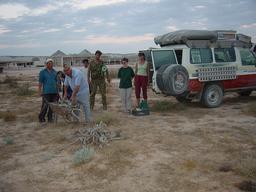 Firewood from the Mullah |
 On the carpet |
The next day we drive through a fantastic canyon landscape and head for Turkmenbashi at the Caspian Sea where we set up our camp right at the beach.
 Fantastic landscape |
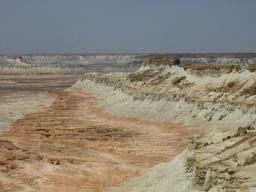 Fantastic landscape |
 Fantastic landscape |
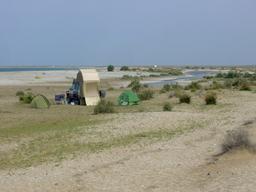 Camping at the Caspian Sea |
South of Turkmenbashi we drive approximately 30 kilometers over the saltpans in the desert to reach Dechistan, a town of the Middle Ages buried under the desert sand. The mosque's distant minaret sticking out of the sand guides the way. We set up our camp near the old city wall and start our excursion into the past. As in Gonur, we constantly stumble over ancient shards of pottery. We feel like real archaeologists.
 Through the desert near Dechistan |
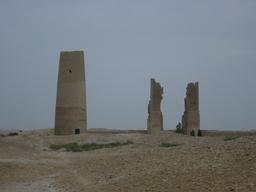 Submerged Dechistan |
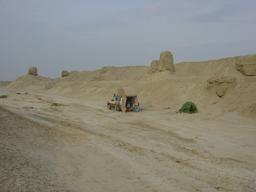 Camping next to the buried city |
Before we delve into the mountains at Kara Kala, we meet two German motorcyclists at the Iranian border who want to join us on our tour. Now it is getting really crowded without the UAZ. We put parts and baggage from the both of them into our land cruiser so that it looks like a tipped-over gypsy caravan. In this corner of the country it is extremely difficult to get diesel fuel. All gas stations are dry. Necessity is the mother of invention! We drive our vehicle directly to an oil field in the desert to tap the diesel generator located there.
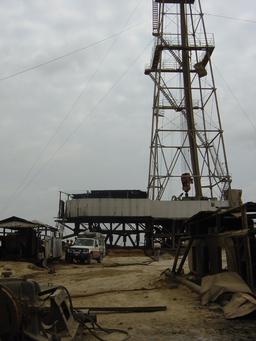 Tanking up at the derrick |
On our mountain tour at the Iranian border the scenery is beautiful and the road is a challenge to drive. Sabine, not yet used to driving off road, wants to leave the vehicle when we are driving the most challenging parts. A distance of 20 kilometers (as the crow flies) actually turns out to be a journey of 80 kilometers, with our land cruiser mostly switched to 4 x 4 LOW (4L). At nightfall we set up our camp at a crest protecting us against wind and a thunderstorm.
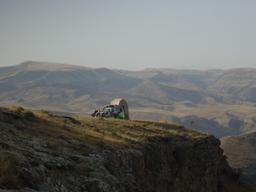 Kara Kala |
After we arrive in the village of Nokhur we are put up in the house of a very friendly family, who slaughter a sheep to celebrate our arrival. Ute and Sabine use the opportunity to do our computer work.
 Slaughtering a sheep |
 Preparing meals |
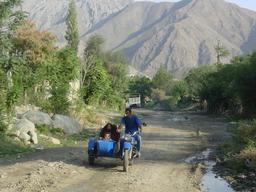 Nokhur main road |
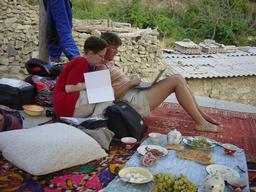 Online on the carpet |
After taking a short "washing" break in Ashgabat we drive on a very bad asphalt road through the Karakum desert heading north to the Uzbek border. This time David accompanies us personally in the meanwhile repaired UAZ vehicle so that we have much less baggage than before. Halfway there we stay overnight in the town of Davazar to experience a special natural phenomenon in the desert. In the darkness we depart and take a sandy road through the desert and follow the glow of fire on the horizon. After approximately 30 kilometers we are standing at a huge crater that resulted from a natural gas explosion many decades ago. The flames in the center look like an oversized flambé with too much rum burning off - purgatory feeling under a clear starry sky.
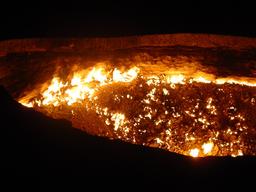 Desert in flames |
In Kohne Urgentsch, the northern-most point on our Turkmenistan journey, we visit the local historical sights.
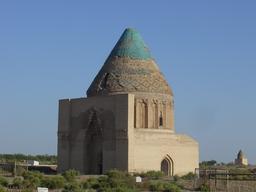 Mausoleum of Sultan Tekesch |
 Memorial mosque |
We find accommodations in a house of a very nice and hospitable family of Korean origin living here in Central Asia "thanks to" Stalin. We also say good-bye to the two motorcyclists Fredy and Matthias who continue their journey to Uzbekistan.
400 Kilometers through the Karakum Desert
To return to Ashgabat, David decides to take a special route. We want to risk driving off road directly through the Karakum Desert. Even the starting point is difficult to find despite the Russian military maps and GPS. We aren' t even 20 kilometers into the desert when David's UAZ radiator starts to leak. The UAZ loses two liters of water an hour, definitely too much for crossing the desert. We set up camp while David returns to the civilized world to get the radiator soldered. The next day we finally start our journey.
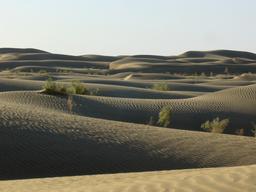 Karakum desert |
 Repairing the motor |
We follow some traces showing us the correct direction until we stand in front of an almost insurmountable obstacle: A canal in the midst of the desert to flood the recently planned Turkmenbashi Lake (Lake of the Golden Century) is being built to drain off agricultural sewage. One thing is certain: We cannot drive around the excavated canal at a length of a few hundred kilometers. We find an excavator at the construction site that pulls us up over the sand bank.
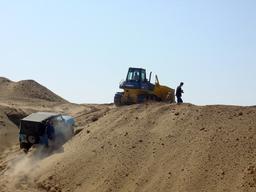 Sometimes help is needed |
 Sometimes help is needed |
We drive another 100 kilometers completely off road, taking routes through the desert, until we reach a small village that, though marked on our map, is deserted due to water shortage. Unfortunately our UAZ becomes the first rolling swimming pool in the desert since the faucet from the drinking water tank breaks off (unnoticed) and the valuable water drips to the ground. Although we still have a water canister with 20 liters, this is not enough for five people. No more washing in the next few days! We say a quick prayer for the UAZ' s radiator. The remainder of the tour reminds us of our Sahara experience: Once again it' s "shoveling and laying the sand plates".
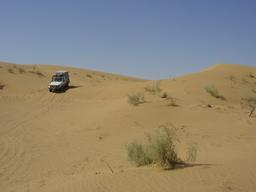 100 kilometers of dunes |
 Stuck in the sand |
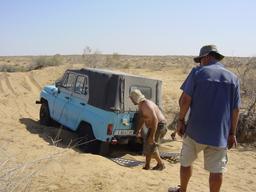 Stuck in the sand |
In the middle of the desert in Adzhkui we come upon a small settlement with a well. We are lucky: Our water problem is solved. We meet very friendly locals who invite us to their traditional clay hut and offer us food. As a gift they give us a desert rabbit when we leave that David makes very tasty that evening!
 Adzhkui |
 Cooking in the camp |
After an additional 200 eventful desert kilometers we know by sighting the first camel herds that villages must be close by. Again we are treated like royalty. There are tasty desert specialties, camel milk and, of course, vodka for the non-drivers.
 Camels |
With heavy hearts we leave the desert and head for Ashgabat that we reach in the darkness after a thirteen-hour trip. The fantastic nature and friendliness of the people in the Karakum desert impressed us deeply.
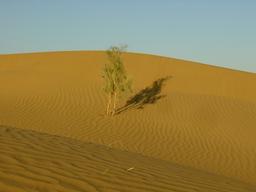 Desert landscape |
We finish our Turkmenistan adventure by visiting a Stone Age settlement north of Ashgabat before we cross the Kopet Dag Mountains heading towards Iran. A different culture in the Near East along the Silk Road waits.
Central Asia consists of Kyrgysistan, Tadshikistan, Kazakhstan, Uzbekistan and Turkmenistan. In two months we have seen three of these countries going from the Pamir Mountains in the east to the Caspian Sea in the west. Our land cruiser took us almost 8,000 kilometers on and off roads, on trails through deserts, steppes, oases and mountains. For many decades the "Soviet Orient" has hardly been accessible to western tourists. Even today, eleven years after these republics achieved independence from the Soviet Union, traveling on your own is not always easy. It has been very remarkable for us to see how different from each other these three former Soviet republics have developed. We' ve experienced Kyrgysistan as a fairly liberal, open and carefree country making it easy for tourists to travel in. The mountains, green alpine pastures, yurts and horses stirred us as well as the open-minded and very likeable people who have kept their nomadic traditions in their hearts.
 Semi-nomads |
In Uzbekistan, where we remained on the typical (very clean) tourist trails, we experienced something out of "1001 Arabian Nights" in the remarkable cities of Samarkand, Bukhara and Chiva on the ancient Silk Road. Currently the country is performing the very difficult balancing act between post-communism and Islamic tradition. Everything is regulated, closely watched - new developments are cautiously permitted and in miniscule doses. Officially everything was given a new name but we suspect it is the same as it always was during the Soviet era. Once you leave the capital city of Tashkent, you immediately recognize the old traditions that are flourishing and being maintained everywhere. Despite an increasing industrialization we recognize the old Uzbek life style all over: Goods are brought to the market by donkey cart or the people comfortably allow the day go by slurping their tea in the shade.
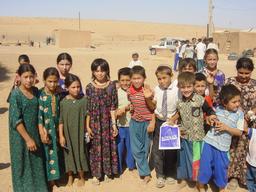 Desert children |
Of all these countries we feel that Turkmenistan is the most severe. Mr. Turkmenbashi had decided in the name of the people to put neutral politics into practice, yet wholly related to him personally. Continual control checks and very high fees for visa and travel permits gave us the feeling that tourists are not actually officially welcome. Anyway, this did not keep us from admiring the gorgeous scenery, cultural sites that have existed for over 7,000 years and getting to know the friendly people. Traveling through Central Asia has been very interesting and left us with strong impressions. We did not expect so many different cultures, traditions and political systems in the various countries. However, becoming an independent state is obviously not easy and requires the people to change their views, which requires time and patience. We say good-bye: "hayr Uzbekistan", "jakshy kalyngydzar Kyrgysistan" and "sagh bol Turkmenistan" and wish the people of Central Asia all the best for the future.